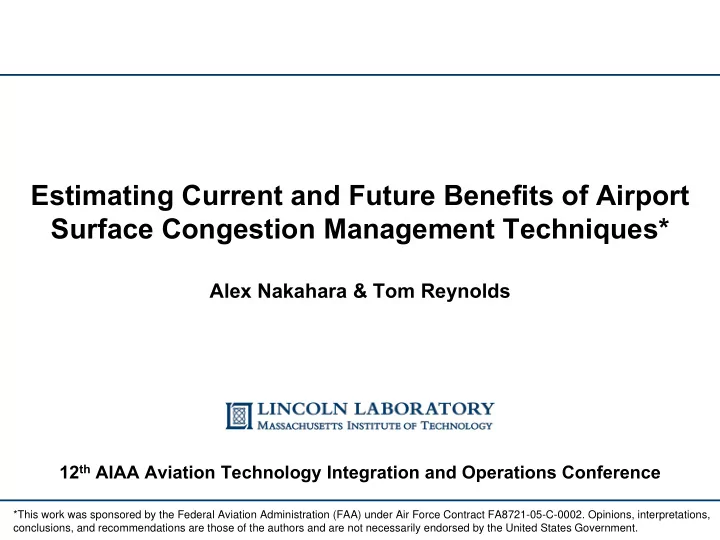

Estimating Current and Future Benefits of Airport Surface Congestion Management Techniques* Alex Nakahara & Tom Reynolds 12 th AIAA Aviation Technology Integration and Operations Conference *This work was sponsored by the Federal Aviation Administration (FAA) under Air Force Contract FA8721-05-C-0002. Opinions, interpretations, conclusions, and recommendations are those of the authors and are not necessarily endorsed by the United States Government.
Outline • Introduction to Surface Congestion Management • Surface Congestion Management Benefits Assessment Methodology • Current and Future Benefits Estimates at 8 key US airports • Conclusions SCM Benefits - 2 09/12/12
Surface Congestion Management (SCM) • Surface congestion => increased taxi times, fuel burn & emissions • Annually, at major airports in the United States (2010 ASPM) – Over 48 million mins taxi-out delay (over unimpeded times) – 194 million gallons excess taxi fuel => $388-582 million @ $2-3/gal • Surface congestion management can help: Excess “Excess” flights held until congestion later time intervals when Max they can be more efficiently Demand on efficiency accommodated Surface limit Time Interval: 1 2 3 4 SCM Benefits - 3 09/12/12
Surface Congestion Management (SCM) • At times of congestion, hold aircraft at gate or other designated location (with engines off) to reduce surface congestion & fuel burn while not adversely affecting throughput – Concepts demo-ed at BOS, JFK, MEM, MCO airports JFK: Pre-metering JFK: Post-metering 15 a/c in 31L queue 8 a/c in 31L queue, 8 being held SCM Benefits - 4 09/12/12
Benefits Assessment Needs & Methodology • Benefits assessment activities required to understand impacts of SCM at different airports and make case for deployment SCM Benefits - 5 09/12/12
Throughput Saturation Curves • Throughput saturation curves at core of methodology Impacts of Airport X, Configuration Y, future capacity Departure rate Condition Z increases Benefits of holding Saturation all flights above throughput, Saturation control point T* Control Taxi time benefits point, N* point, N ctrl =N Congestion ( τ Congestion – τ Ctrl ) Traffic Metric, e.g. No. of aircraft on surface, Dep queue length, etc. • Current year: curves can be established from operational data • Future years: curves estimated from demand/capacity forecasts SCM Benefits - 6 09/12/12
Simulations • Inputs Simulation – Current year: ASPM OOOI, ASDE-X Current Year – Future year: FAA demand/capacity Analysis predictions 2015, 2020, 2025, 2030 Operational Data • Future year saturation curves Future Year – Random Forest method Saturation – Forests “grown” on 2000-2010 data Curve Prediction – Relationships between key input Future Year Analysis vars, N* & T* => future year N* & T* Future Schedules Future • Future year traffic simulations Year Traffic Simulations – Simple queuing model of taxi time as f(future yr demand, service time) – Operating point on future yr curve SCM Benefits - 7 09/12/12
Results Generation/Validation • Current year validation – Simulated current year benefits estimates compared to field trial results where available • BOS, JFK • Future year estimation – Operating point on curve => “unconstrained” benefits calculated at each future year – Limited gate/hold space physical constraints – Benefits in last year with sufficient gate/hold space => “practical benefits” – Taxi time & fuel burn benefit metrics SCM Benefits - 8 09/12/12
Gate/Hold Space Constraints • Gate utilization calculated for each airport & year & compared to number available SCM Benefits - 9 09/12/12
Results: JFK Airport • Unconstrained benefits rise over time as demand increases without added capacity • Practical benefits capped at 2015 levels due to gate constraints • Validation against field trial results SCM Benefits - 10 09/12/12
Results: Aggregate Across Study Airports • Fuel burn benefits estimation using ICAO ground idle fuel flows • Dominant airports: JFK, ATL, ORD • Gate constraints limit benefits at different years SCM Benefits - 11 09/12/12
Results: Aggregate Across Study Airports Practical Benefits Aggregated 2010-2030 Thousand Savings as % of Airport Fuel Saving Fuel Cost Savings as % of Hours Taxi taxi-out fuel Million Gallons ($2.43/gal) total fuel cost Time Reduction cost ATL 965 242 $587m 21% 1.2% BOS 59 13 $31m 4% 0.2% DFW 105 27 $66m 4% 0.2% IAD 177 36 $86m 11% 0.6% JFK 1060 381 $926m 35% 1.9% LGA 326 65 $157m 22% 1.2% ORD 390 95 $231m 10% 0.5% PHL 455 92 $223m 20% 1.1% TOTALS 3,537 949 $2.4bn 18% wt. av. 1.0% wt. av. • Fuel cost of $2.43/gallon per FAA recommendation – Higher fuel costs => proportionately higher fuel cost savings • % taxi-out and total fuel estimates based on actual fuel upload at each airport from 2010 BTS data and scaled to future traffic SCM Benefits - 12 09/12/12
Conclusions • Surface congestion management is an effective solution for addressing surface inefficiencies • Need for current & future year benefits assessment • Methodology and simulations developed to develop benefits estimates at 8 key US airports • Total practical benefits estimated to be over $2bn fuel saving ( ≈ 18% of taxi-out and 1% of total) at study airports over 20 yrs • Related work: – Create system-wide benefits estimates – Explore practical SCM implementations at range of airports SCM Benefits - 13 09/12/12
Recommend
More recommend